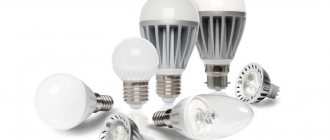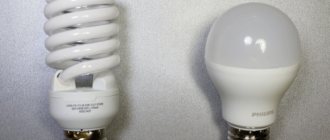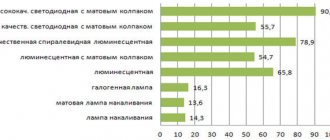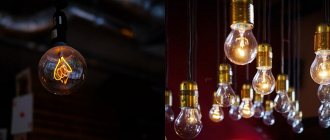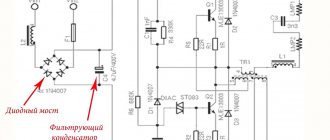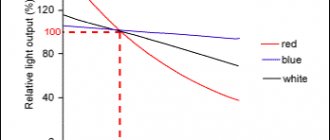For many decades, Russians bought lamps for lighting based on watts.
Another indicator is more important - the luminous flux of the lamp, measured in lumens and showing how much light a particular source provides.
Lighting calculations are based on this parameter.
To replace incandescent lamps with LED lamps, it is important to know these characteristics.
What is luminous flux
In fact, to calculate illumination, designers previously used another value - candela (candle), which also has a direct correspondence to the watts consumed by an incandescent lamp. In the technical literature of the beginning of the second half of the last century one can find the expressions “thousand-candle lamp”, etc. Brightness in candelas refers to the power of light in watts emitted in a particular direction. As a visual association, such brightness is provided by an ordinary burning paraffin or stearin candle. Hence the name. This approach provides a visual representation of brightness as the number of candles burning.
The brightness of the glow is one candela
Important! The watts used to calculate candelas are not related to electrical power - the light source may not be electric (the same candle).
There is a definition for the concept of luminous flux - the power of radiation energy, which is assessed by the sensation of light. Or the number of photons emitted per unit time. Mathematically, it looks like this: if a point source with an intensity of 1 candela emits a flux into a solid angle equal to one steradian, then it creates a luminous flux of 1 lumen (lm).
Graphic representation of the steradian
The concept of steradian requires clarification. To represent a solid angle of 1 sr, you need to take a cone with a vertex at the center of a sphere of radius R, which cuts out an area equal to R2 on the surface of the sphere. The opening angle of such a cone is about 65 degrees.
If a point source of light of 1 candela, emitting equally in all directions, is placed in a sphere with a radius of 1 m, then an illumination equal to 1 lux (lx) will be created on its inner surface. This value is used to set lighting standards. Thus, for various premises, according to SNiP, the following conditions must be met:
- classrooms of secondary schools – 500 lux;
- university audiences – 400 lux;
- gyms – 200 lux.
Lighting standards have also been established for other rooms.
If a luminous flux of 1 lm falls on 1 sq.m. surface, it creates an illumination of 1 lux. Hence the connection between lumen and lux: 1 lux = 1 lm/sq.m. For example, to provide sufficient illumination in a classroom of 100 square meters, a luminous flux of 40,000 lumens is needed. It is also necessary to take into account that illumination decreases in proportion to the square of the distance from the light source, so the height of the lamp suspension matters.
⇡#Pros and cons
LED lamps have many advantages compared to conventional incandescent lamps:
- Economical - with the same amount of light, a modern LED lamp consumes 7-10 times less electricity.
- Durability - an LED lamp lasts 15-50 times longer than a conventional one.
- A little heating - the child will not get burned on the LED lamp in the table lamp.
- Same brightness at different mains voltages - unlike incandescent lamps, LED lamps shine just as brightly at lower mains voltages.
- The ability to install an LED lamp, much brighter than an incandescent lamp, in a lamp that has a power limitation.
- The light of good lamps is visually indistinguishable from the light of incandescent lamps.
There are also advantages when compared with compact fluorescent (energy-saving) lamps (CFL):
- Environmental friendliness - absence of hazardous substances (the bulb of any CFL contains mercury).
- Economical - the lamp consumes less energy with the same luminous flux.
- The LED lamp instantly lights up to full brightness, and the CFL smoothly increases brightness from 20% to 100% in a minute at room temperature and much more slowly at low temperatures.
- CFLs have a poor spectrum consisting of peaks of several colors. The spectrum of an LED lamp is much closer to natural light and incandescent light.
But, of course, there are also disadvantages:
- High price.
- The presence on the market of lamps with poor light quality (pulsation, poor color characteristics, uncomfortable color temperature, discrepancy between the luminous flux and the incandescent lamp equivalent declared).
- Some lamps have problems with switches that have an indicator.
- Only some expensive models support brightness adjustment (dimming).
Let's figure out the savings
The main advantage of LED lamps is energy savings. For the same amount of light emitted by the lamp, an LED lamp consumes 7-10 times less electricity than a conventional incandescent lamp. You can now buy 6-watt LED bulbs and 4-watt LED bulbs, which provide the same amount of light as a 60- and 40-watt incandescent bulb, respectively.
I calculated what the electricity costs would be when lighting a two-room apartment with conventional and LED lamps. Of course, this is an approximate calculation, but it allows you to get an idea of the order of the numbers of possible savings.
Calculation of savings for a two-room apartment
The packaging of any incandescent lamp indicates a service life of 1,000 hours. If the lamps actually work for 1,000 hours (unfortunately, they often burn out much earlier), the lamps in the hallway and room will have to be changed twice a year, and in the kitchen and bedroom once. If a lamp costs 30 rubles, it will cost 690 rubles to buy new lamps. LED lamps do not have to be changed every six months, because their service life is 15-50 thousand hours. This is from 7 to 22 years when used 6 hours a day.
The purchase of lamps for this apartment will cost 4,045 rubles (7 E27 6 W lamps for 240 rubles, 11 “candles” 4 W for 215 rubles), and they will pay off in less than a year.
LED and energy saving lamps
LED bulbs are undoubtedly energy efficient, but the word “energy efficient” is attached to compact fluorescent lamps (CFLs), and CFLs and LED bulbs are very different things.
Compact fluorescent lamp and LED lamp
CFLs became widely available about ten years ago and were expected to replace incandescent lamps. However, CFLs turned out to be a dead-end branch of evolution. These lamps have many disadvantages: the lamp tube contains mercury, the lamp lights up slowly and does not shine at all in the cold, CFLs have a poor spectrum, consisting of peaks of several colors.
From July 1, 2016, in accordance with Decree of the Government of the Russian Federation No. 898 of August 28, 2015, all state and municipal enterprises and institutions will be prohibited from purchasing any lamps containing mercury (including CFLs) through the public procurement system. Already, the number of CFLs in stores is constantly decreasing, and soon they will disappear completely.
Let's compare the light spectrum of an incandescent lamp, a fluorescent lamp and an LED lamp.
Spectrum of incandescent lamp, fluorescent lamp and LED lamp
The spectrum of an LED lamp is much closer to natural light and incandescent light.
A little history
The glow of a semiconductor transition was first discovered in 1923 by the Soviet physicist Oleg Losev. The first LEDs were called “Losev Light”. First the red LED appeared, then yellow and green LEDs appeared in the early 70s. The blue LED was created in 1971 by Yakov Panchechnikov, but it was very expensive. In 1990, Japanese Suji Nakamura created a cheap and bright blue LED.
Oleg Losev and Suji Nakamura
After the advent of the blue LED, it became possible to make white light sources with three crystals (RGB). Such sources are still used in concert and decorative lighting.
RGB LED
In 1996, the first white LEDs using a phosphor appeared. In them, blue or ultraviolet LED light is converted to white using a special chemical applied on top of light-emitting crystals.
Phosphor LED
In 2005, the efficiency of such LEDs reached 100 lm/W, which made it possible to begin using phosphor LEDs for lighting. Now the most efficient white LEDs already produce 200 lm/W, commercial lamps with standard sockets - up to 125 lm/W.
Types of LED lamps
LED lamps replicate all possible types of incandescent, halogen and fluorescent lamps. We produce regular lamps - “pears”, “candles” and “balls” with E27 and E14 sockets, “mirror” lamps R39, R50 with E14 sockets, and R63 with E27 sockets, spots with GU10 and GU5.3 sockets, capsule microlamps with sockets G4 and G9, lamps for ceilings with socket GX53.
Types and sockets of LED lamps
LED lamps use different types of LEDs. The very first LED lamps used conventional LEDs in a plastic housing. Such lamps were called “corn” for their visual resemblance to an ear of corn.
Corn lamp
Nowadays, LEDs in housings are used quite rarely in lamps, and, as a rule, these are high-power LEDs.
LED lamps with powerful LEDs in housings
Most modern lamps use bulk LEDs and LED assemblies.
Bulkhead LED lamps
Recently, COB (chip on board) LED emitters have been increasingly used. In them, many LEDs are coated with a single phosphor.
COB lamps
A type of COB is LED filament, in which many LEDs are placed on a metal, glass or sapphire strip coated with a phosphor.
LED filament design and filament lamp
Even the Russian word “filament” appeared, which some manufacturers began to use.
Another newer technology is Crystal Ceramic MCOB. There are many LEDs located on a transparent ceramic plate. The plate is coated with phosphor on both sides, so such an emitter shines almost evenly in all directions.
Lamp with Crystal Ceramic MCOB emitter
The quality of light from an LED lamp is affected by five main parameters. Let's look at each of them in detail.
Principle of operation
To understand the convenience of using all these quantities, we need to consider the direction of LED emission, and related concepts.
Angles of LED illumination with lens
The design of the light-emitting diode is such that it does not send light evenly in all directions - the lower hemisphere is covered by a substrate, and the design of the lens is such that it does not provide uniform radiation in the upper hemisphere. As a result, the main light flux is concentrated in the upper direction and weakens towards the periphery of the light cone. At a certain viewing angle, the intensity of the glow is reduced by half, and when an even greater angle is reached, the light becomes invisible. The first angle (bac) is called the half brightness angle, and the second (fah) is called the full brightness angle.
Luminous angles of an LED with phosphor
The same points apply to an LED with a phosphor. There, the radiation angle is limited by the substrate and the angle of greatest activity of the initiating radiation of the pn junction. You must understand that it is impossible to accurately determine these angles by eye - special instruments are needed. But you can visually compare two LEDs - which one has a larger opening angle.
How is luminous flux measured?
Roughly speaking, this is a kind of efficiency. The unit of light output is Lumen/Watt.
Simple incandescent, fluorescent, DRL, NL and LED bulbs of the same power have different luminous efficacy.
This parameter is most common for LED elements. And a simple 100-watt light bulb has the lowest efficiency. Only 2% of all energy spent goes to lighting.
However, here a lot depends on the lamp itself, its shape, design, manufacturer, etc.
If most of the parameters for different lamps are the same, then the main factor in choosing a particular light source is its luminous efficiency.
Many of you have probably wondered, what is better and more economical - to hang just a light bulb in the room or a light bulb in a lamp? This is where a parameter such as light output comes to the rescue.
To find it out, you need to divide the luminous flux of the light source by the power of the lamp. As a result, we get data measured in Lm/W.
Luminous output of LED lamps
The light output of LED lamps does not depend on the degree of heating of the crystal. Almost all white illuminators are made on the basis of LEDs with a phosphor, so the luminous efficiency depends on the quality of this phosphor and the technology by which it is produced. Also important is the light emission of the initiating crystal and the ability of this radiation to cause the glow of the phosphor in the visible part of the spectrum.
Powerful white LED with phosphor
How to choose the right LED lamp
To choose a lamp that will create comfortable lighting, will last a long time, will not cause harm to health and will significantly save energy, use the following tips.
- The color spectrum of a lamp for an apartment should not exceed 3,000 K. If you need a lamp for an office, choose a temperature of 4,000 K. Lamps of 6,000 K and higher should be used only in utility rooms.
- Choose lamps with a voltage range of 110–230 V.
- The color rendering index must be at least 80 CRI.
- Lamp ripple should not exceed 15%. You can easily check it in a store: screw the light bulb into the socket and hold your smartphone camera to it. If the pulsation is high, the image on the screen will flicker.
- Be sure to check the lamp's functionality. Almost all electrical stores have a similar option.
Luminous flux of outdoor lighting
To calculate outdoor lighting, one must proceed from the minimum illumination standards, which can also be found in the relevant SNiP (SP). So, for children's playgrounds, the minimum illumination should not be less than 10 lux.
The standards give minimum illumination values; they can be increased during calculations.
To obtain the required number of lamps (N) to obtain the required illumination, you need to set the initial data:
- minimum illumination (E), lux;
- area (S), sq.m.;
- illumination unevenness coefficient (z), for LED lamps it is equal to 1.2;
- a multiplier that takes into account the weakening of the luminous flux at the end of the lamp's service life (k), for LED devices it is equal to 1.2;
- luminous flux of one lamp (F), lm;
- the coefficient for taking into account the reflection of objects located nearby (n), for asphalt it can be taken as 0.3.
These quantities are related by the formula N=E*S*z*k/(F*n).
Playground lighting
Suppose you need to illuminate a children's playground with an area of 150 sq.m. There are lamps emitting a luminous flux of 1500 lm each. Substituting the values into the formula, we get N=10*150*1.2*1.2/(1500*0.3). You will get 4,8 or 5 lamps. This is the minimum quantity; in fact, more can be installed.
You can ask not the luminous flux of the existing lamps, but the number of lamps that can be installed on the territory. In this case, it is necessary to calculate the luminous flux of each lamp. The calculation formula will take the form F=E*S*k*z/(N*n). If the final result does not fall into the standard range of lamp characteristics, it must be rounded up.
Are all LED lamps good and if not, how do good ones differ from bad ones?
In ordinary incandescent lamps everything is simple: a bulb and a tungsten filament.
An LED lamp is much more complex and its quality depends on the quality of the LEDs, phosphor and electronics. There are three important parameters that affect the quality of light a lamp produces:
• Light pulsation. Many low-quality lamps have a high level of light pulsation (flickering). Such light is visually uncomfortable and a person quickly gets tired of it. When you move your gaze from one object to another, a stroboscopic effect is visible (as if several objects are visible instead of one). The human eye perceives pulsation of more than 40%. There are two ways to check for the presence of light pulsation - the pencil test (we take an ordinary long pencil by the tip and begin to quickly, quickly move it in a semicircle back and forth. If individual contours of the pencil are not visible, there is no flickering, but if “several pencils” are visible, there is light flickers) and checking with a smartphone camera (if you look at the light through a smartphone camera, as a rule, when the light flickers, stripes will appear across the screen, and the brighter they are, the stronger the flickering). Lamps with visible pulsation should not be used in residential areas.
• Color rendering index (CRI). The light spectrum of an LED lamp is different from that of sunlight and the light of a conventional incandescent lamp. Although the light appears white, it contains more of some color components and less of some. CRI measures how uniform the levels of different color components are in light. With a low CRI of light, shades are less visible. Such light is visually unpleasant, and it is very difficult to understand what is wrong with it. Incandescent and solar lamps have CRI=100, ordinary LED lamps have more than 80, and very good lamps have more than 90. It is better not to use lamps with a CRI below 80 in residential areas.
• Lighting angle. LED pear lamps come in two types. For the former, the protective cap has the shape of a hemisphere, having the same diameter as the body. Such lamps do not shine back at all, and if they shine downward in a chandelier, the ceiling will remain dark, which can be visually unsightly. In the second type of lamp, the transparent cap has a diameter larger than the body and the lamp shines slightly backwards. Lamps using LED filaments or transparent disks have the same wide illumination angle as conventional incandescent lamps.
Halogen spotlights produce a narrow beam of light with an illumination angle of about 30 degrees, and most LED spotlights produce diffused light with an angle of about 100 degrees. Such light bulbs in a suspended ceiling “blind” due to the angle being too wide. Only some LED spotlights have lenses and the same narrow lighting angle as halogen lamps.
And three more problems that can often be encountered with LED lamps:
• Inconsistency of luminous flux and equivalent with the declared values. Unfortunately, overestimated values of luminous flux and equivalent are often written on the packaging of LED lamps. You can find lamps that indicate a luminous flux of 600 lm and that the lamp replaces a 60-watt incandescent lamp, but in fact it only shines like a 40-watt lamp.
• Color temperature does not match the stated one. Very often there are lamps whose light color temperature differs from what the manufacturer promises. Instead of 2700K you can find 3100K, and instead of 6000K even 7200K.
• Premature failure of lamps. Manufacturers indicate the service life of LED lamps from 15,000 to 50,000 hours, but in fact the lamps sometimes break after several months of operation.
The relationship between lumens and watts
Consumers around the world, over decades of incandescent lamp dominance, have become accustomed to relating lighting brightness to electrical power consumption. For these outdated devices, this was reasonable - the development of technology in this direction had long ago reached a dead end. The ratio of power and lighting intensity has become established and has become a habit.
For LED lighting, there is no direct relationship between the power consumption in watts and the luminous flux produced in lumens . More precisely, it exists, but only for the current moment. Technologies do not stand still, the production of crystals is being improved, and new phosphors with increased light output are being developed. The relations of the present tense will tomorrow turn out to be hopelessly outdated.
Luminous flux tables for LED and fluorescent lamps
LED lamp luminous flux table
Below are the indicators of SMD tapes, taking into account the power and type of housing, including SMD 3528 and smd 5050. These indicators are also relevant for RGB tapes.
Luminous flux table for fluorescent lamps
Here we compare the performance of different types of fluorescent lamps
Demonstration of comparison of standard fluorescent and LED lamps:
Both fluorescent and LED lamps are the most common on the lighting products market. Luminous flux is an important parameter, understanding and knowledge of which will make the buyer more knowledgeable about the design of the lamp, which means the likelihood of making a mistake when choosing is reduced.
Light brightness table
Currently, the correspondence between the luminous flux of modern LED lamps and their power consumption looks like this:
| Luminous flux, lm | 250 | 400 | 650 | 1300 | 2100 |
| LED lamp power consumption, W | 2-3 | 5-7 | 8-9 | 14-15 | 22-27 |
| Equivalent incandescent lamp power, W | 25 | 40 | 60 | 100 | 150 |
The table shows approximate rounded values, since the lamps on the market have been produced over several years by different manufacturers using different technologies. For perception “by eye” this scatter is practically not noticeable.
In conclusion, the video: The difference and relationship between watts, lumens and kelvins.
Having a clear understanding of the relationship between the characteristics of light radiation, you can independently calculate the lighting of a room or area. To do this, you need to know the lighting standards and technical characteristics of LED lamps.
Comparison tables between incandescent and LED lamps
In everyday life, light sources with a power similar to incandescent light bulbs of 40, 60, 75, 100 watts are used.
The easiest way to find the LED equivalent is in the table:
| LN power (W) | Power- luminosity diode (W) | Luminous flux (lm) |
| 25 | 2-3 | 220-250 |
| 40 | 4-5 | 400 |
| 60 | 8-10 | 700 |
| 75 | 10-12 | 930 |
| 100 | 12-15 | 1340 |
| 120 | 18-20 | 1700 |
| 150 | 22 | 1800-2100 |
| 200 | 25-30 | 2500-3040 |
Incandescent lamps last no more than 1000 hours, LED lamps – 30-50 thousand hours (from leading manufacturers).
Luminous efficiency (efficiency) shows what part of the energy used by the source is given off in light radiation, and is measured in lux (lm/W):
- an incandescent light bulb has an average value of 12 (depends little on the power of the sources used in everyday life);
- for halogen – 15;
- for an LED – 80-90 (depending on the brand).
Light output determines the CPC of the source. For LN this parameter is 5-10%, for LED it is 40-90% (depending on the brand).
The pulsation coefficient of a light source with an incandescent filament can reach large values - 15-25%. A high-quality LED has only 0-5%.
An important indicator is heat transfer.
For incandescent lamps it is proportional to the power:
- 25 W – 100°C;
- 40 W – 145°C;
- 60 W – 180°C;
- 75 W – 250°C;
- 100 W – 290°C;
- 200 W – 330°C.
Such a high temperature limits the scope of application. It is prohibited to install light bulbs with a power of more than 60 W in suspended ceilings. You should not purchase them for lamps with elements made of fabric, plastic, or wood. The maximum LED temperature for household use is 65°C.
The temperature of the LED source bulb with a base with a power of 10 V (35 ° C) allows you to touch it with your hands.
The price of an LED lamp is approximately 10 times higher than that of a product with an incandescent filament. This is the first thing that an ordinary buyer pays attention to, without going into details.
It would be more correct to carry out the calculations as in the table (data for a two-room apartment, the inhabitants of which go away for 10 hours on weekdays):
| Premises | Opening hours per day | Opening hours per year | LN power | Power St. | LN consumption per year (kW) | Consumption of St. in year (kW) |
| Room 1 | 6 | 2190 | 200 | 25 | 438 | 54,75 |
| Room 2 | 3 | 1095 | 150 | 22 | 153 | 24 |
| Kitchen | 3 | 1095 | 200 | 25 | 153 | 24 |
| Bathroom | 1,5 | 548 | 60 | 8 | 33 | 4,3 |
| Hallway | 3 | 1095 | 60 | 8 | 65,7 | 8,7 |
| 842,7 | 115,75 |
The table shows that electricity consumption for lighting after replacement is reduced by 7 times. Although the calculations are approximate, the savings are obvious.
Additionally, it is necessary to calculate the savings from changing sources. LNs do not always work for the stated 1000 hours, so they will not last for a year; they will have to be changed in each room. LEDs will always last longer if you do not buy them from an unknown Chinese manufacturer. In addition, LN is easy to break, which can also entail additional costs.
How to determine luminous flux and power
Determination of the flux and power of the lamp can be done using a special table, which is given below. To make your own measurements, you can use a spherical photometer or photometric goniometer. The main problem of independently finding the necessary data will be determining the parameters of the beam, which moves simultaneously in several directions.
Thanks to a spherical photometer, you can measure the energy of a scattered beam having a unit reflectance, and then compare the result with a standard. Using a photometric goniometer, which contains a lux meter, you can measure the illuminance over the entire source sphere. The received data is integrated into lumens.
You can also take the measurement yourself using a lux meter. At the end of the procedure, the data on illumination and area of the room are recorded, and then this information is substituted into the formula for calculating the beam: P=OPl.
You might be interested in: Features of metal halide lamps
Measuring device lux meter to help
Why such difference?
To answer this question, let's briefly look at the operating principle of each type of light bulb and compare their energy consumption. In an incandescent light bulb, the working element is a tungsten filament, which must be heated to 2000-3400°C to make it glow brightly. At the same time, approximately 95% of the lamp’s power consumption is spent maintaining the temperature of the coil, which means its efficiency will be only about 5%.
The operating principle of a compact fluorescent lamp (CFL) is to produce UV radiation by passing current through mercury vapor and then converting it into visible light using a phosphor layer. The energy efficiency of modern CFLs is approximately 5 times higher than their filament counterpart.
In LED light bulbs, light is produced by passing current through a pn junction and then passing it through a phosphor. The ratio of light energy to total power of the latest generation LED lamps can reach 30%. But there is no exact efficiency value for all LED bulbs, since it greatly depends on the type of LEDs and driver used.
